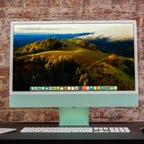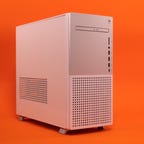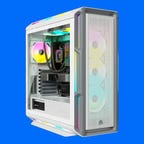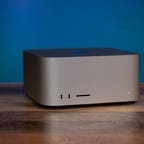Best Desktop Computer for 2024
These are CNET editors’ top picks for best desktop computers (both Macs and Windows PCs), plus advice on what you should look for in your next desktop.
What to consider
Price
Operating system
Processor
Graphics
Memory
Storage
Display
Our Picks
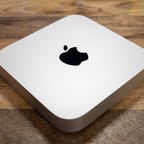
What is the best desktop computer overall?
The best desktop for most people is Apple’s new M3-based iMac. It integrates the display and offers everything you could want in an all-in-one. For a reasonable sum, the iMac provides a fantastic design centered on a high-resolution, 24-inch display powered by Apple’s new M3 processor. Performance from Apple’s latest silicon is, without a doubt, impressive on all counts. If you need more screen space than you'd get with a laptop, the 24-inch iMac gives you added room on which to work and play. Yet, with its compact design and power cable that magnetically pops into place, the iMac is easy to relocate from room to room. The computer is also available in seven fun colors with accessories to match.
If you're looking for a traditional tower desktop or a small-form-factor PC instead of an all-in-one like the iMac, then keep reading because we also have recommendations for those. We also have favorite all-in-ones based on Microsoft Windows and Google’s ChromeOS.
Laptops occupy the majority of our editors' time and effort with CNET's hands-on reviews, but desktops still pass through the CNET Labs on occasion. Many of our current desktop recommendations are based on previous versions that we tested and reviewed. We also have general PC configuration suggestions that we haven't specifically tested but are based on our experience with similarly configured computers. These guidelines should be helpful if you're looking for the best cost-value when customizing a PC to order. We'll update this best desktop computer list periodically.
Best desktop computers of 2024
The 24-inch iMac is especially well-suited as a family computer or if you want something other than a laptop to easily move from room to room. It's small enough to squeeze into tighter spaces, like a kitchen nook, but big enough to spread out your work, kick back and stream a movie or do some casual gaming. With the recent update to Apple’s M3 processor, the iMac is a much more capable machine for content creation and gaming.
The iMac starts at $1,299 for a configuration that features an M3 chip with an eight‑core CPU (four performance cores and four efficiency cores), an eight‑core GPU and a 16‑core Neural Engine. This baseline model also features 8GB of RAM, a 256GB SSD and two Thunderbolt USB-C ports. It also includes Apple’s Magic Keyboard and Magic Mouse. An upgraded M3 chip with two more GPU cores is available, and you can also choose to expand the memory and SSD capacity.
Best cheap desktop alternative to a MacBook or iMac
Apple Mac Mini (2024)
The Mac Mini desktop is one of Apple's longest-standing product lines, dating back to 2005 (in a pre-Intel version), a year before the first MacBook. All these years later, it retains the same basic shape and appeals to much of the same audience. Unlike Apple's MacBook Pro and Air laptops, or the iMac desktop, the Mini is designed to work behind the scenes, fitting into small spaces and pairing with your choice of display and input devices.
At $599 (£649, AU$999) to start, the M2 Mac Mini remains the least expensive way to get a MacOS computer by a large margin. It's regularly discounted at Amazon and elsewhere online. The relatively ancient M1 MacBook Air from 2020 is the closest competitor price-wise, at $999. The M2 Pro version of the Mac Mini starts at $1,299.
Best mainstream desktop for gaming
Dell XPS 8960 Desktop
While we like all-in-ones for their convenience, they're not easy to upgrade (if they can be at all). Dell's XPS 8960 Desktop is compact and quiet enough for a small workspace but can be loaded with a 13th-gen Core i9 processor, an Nvidia GeForce RTX 4080 graphics card, up to 32GB of memory and 3TB of storage (with room inside for more). If you have modest needs now but want the room to add in components down the road, the base XPS 8960 starts at $1,550 with RTX graphics and is frequently discounted. If you do plan to upgrade down the road, spend a little extra for its 750- or 1,000-watt power supply.
Best highly customizable gaming PC
Origin PC 5000T
If you're dissatisfied with the lack of configuration options available for prebuilt gaming desktops, going with a custom builder is the best way to sate your appetite. The cost of a custom-configured system that's fully decked out might be too costly for PC users. Many people don't need everything maxed out, even for gaming, but you can get reasonable configurations for about half the price of the $5,000-plus system we tested.
Origin PC builds good, solid systems. Unless you're looking for something dirt cheap, you'll be able to put together something you like at a price you tolerate. Origin's Neuron series starts at around $2,000, and the high-end Genesis line begins at roughly double that. A pre-configured Orgin Genesis 5000T, for example, costs $5,796 and features a Core i9-13900K, 64GB of RAM and GeForce RTX 4090 graphics.
Best mainstream Mac desktop
Apple Mac Studio (2024)
The Mac Pro has long been the top dog in Apple's computer lineup but starts at a whopping $6,999. By comparison, the mainstream Mac Studio is far more affordable, starting at a reasonable $1,999. The baseline model features Apple's M2 Max processor, 32GB of RAM and a 512GB SSD. The step-up $3,999 model bumps you up to the more powerful M2 Ultra chip while doubling the RAM and SSD capacity. Either model is essentially a Mac Mini on steroids, and for anyone who doesn't want to shell out for a Mac Pro, it's a great pick for running creative-centric Mac apps, including animation, graphics, video-editing and audio-editing software.
Best big-screen desktop
HP Envy 34 All-in-One PC
Both Apple and Microsoft have discontinued their bigger-screen all-in-one desktops, so as one of the sole remaining premium big-screen options, the HP Envy 34 AIO is almost the best choice in that class by default.
It's a fine system with a nice 34-inch display and some useful features, like a magnetically attachable webcam and Qi charging pad in the base, although you're paying for pretty and not for performance. We liked the HP Envy 34 AIO when we looked at a previous model last year, and it certainly feels like a nice home or traditional office system for people who need big screens in a small space. The two models are a generation behind Intel's current 13th-gen chips and offer either a 12th-gen Core i5 or i7. The former offers mobile GTX graphics, and the latter supplies a more capable yet still mobile RTX 3060 GPU for creative work and even a bit of casual gaming. The 12th-gen model has a list price of $2,000 but is almost always on sale for hundreds less.
Best all-in-one desktop for tight budgets
HP Chromebase AiO 22
Compact all-in-one desktops make good centralized family computers. The HP Chromebase takes it a step further by pairing one with the simple and secure Chrome OS, the same operating system found on the Chromebooks your kids probably use at school. With a 21.5-inch touchscreen attached to a gray fabric-covered base, the desktop looks like a supersized version of Google's own Nest Hub smart display (and with Google Assistant baked in, you can use it like one, too). Inside is up to an Intel Core i3-10110U processor, up to 16GB of memory and up to a 256GB SSD. The full-HD display even rotates vertically, perfect for viewing vertical videos, following recipes or scrolling your favorite sites.
How we test desktops
The review process for desktops consists of two parts: performance testing under controlled conditions in the CNET Labs and extensive hands-on use by our reviewers. This includes evaluating a device's aesthetics, ergonomics and features with respect to price. A final review verdict is a combination of both objective and subjective judgments.
We test all desktops with a core set of benchmarks, including Primate Labs Geekbench 5 and 6, Cinebench R23, PCMark 10, a variety of 3DMark benchmarks (whichever can run on the desktop), UL Procyon Photo and Video (where supported), and our own battery life test. If a desktop is intended for gaming, we'll also run benchmarks from Guardians of the Galaxy, The Rift Breaker (CPU and GPU) and Shadow of the Tomb Raider.
For the hands-on, the reviewer uses it for their work during the review period, evaluating how well the design, features (such as the screen, camera and speakers) and manufacturer-supplied software operate as a cohesive whole. We also place importance on how well they work given their cost and where the manufacturer has potentially made upgrades or tradeoffs for its price.
The list of benchmarking software and comparison criteria we use changes over time as the devices we test evolve. You can find a more detailed description of our test methodology on our page on how we test computers.
Factors to consider when buying a desktop computer
Price
You can find a good PC tower from brands like Acer, Asus, Dell or HP for between $500 and $600 that will prove useful for years for general use. The specs we'd suggest for a basic Windows 11 machine:
- Intel Core i5 (12th- or 13th-gen) or AMD Ryzen 5 (5000, 6000 or 7000 series)
- Default integrated graphics (such as Intel UHD or Iris or baseline AMD Radeon)
- 16GB of RAM or more
- 512GB or larger NVMe SSD drive
- Four or more USB 3.1 or 3.2 ports with USB-C and USB-A formats (at least one or two on the front)
- Wi-Fi and Bluetooth wireless
- At least one PCI-E (x16) expansion slot (for adding a video card)
Do you want to do some PC gaming, or do you spend time editing photos or videos? You'll want to level up the configuration with more RAM and better graphics options. Expect price points to be between $800 and $1,200 (or even higher) if you go for a more bleeding-edge video card.
- Nvidia RTX or AMD Radeon RX graphics card (GPU)
- 16GB of RAM or more
- 450-watt (or more) power supply
Operating system
Microsoft Windows and Apple's MacOS do basically the same things, but they do them differently. Unless there's an OS-specific application you need, go with the one you feel most comfortable using. Most desktops run Microsoft Windows while Apple’s iMac, Mac Mini, Mac Studio and Mac Pro desktops feature Apple’s MacOS. There is also the odd Chromebox offering based on Google’s ChromeOS. A Chromebox is easier to use and usually cheaper than a Windows PC or Mac but can’t run Windows or Mac software.
Processor
The processor, aka the CPU, is the brain of a desktop. Intel and AMD are the main CPU makers for Windows desktops. Both offer a staggering selection of processors. You can head to Intel's or AMD's sites for explanations so you get the performance you want. Intel's current lineup is its 13th generation of Core chips, with 14th-gen processors expected in early 2024. AMD's current desktop processor is its Ryzen 7000 series. Generally speaking, though, the faster the processor speed and the more cores it has, the better the performance will be.
Apple makes its own chips for Macs, which makes things slightly more straightforward. The Mac Mini features an M2 or M2 Pro processor, and the new iMac is the first Mac desktop with the M3 chip. The Mac Studio features either an M2 Max or M2 Ultra while the Mac Pro is based on the M2 Ultra. Again, generally speaking, the more cores it has, the better the performance.
Graphics
The graphics processor (GPU) handles all the work of driving the screen and generating what gets displayed, as well as speeding up a lot of graphics-related (and increasingly, AI-related) operations. For Macs, Apple's M2 and M3 processors integrate the GPU. For Windows desktops, there are two types of GPUs: integrated (iGPU) or discrete (dGPU). As the names imply, an iGPU is part of the CPU package, while a dGPU is a separate chip with dedicated memory (VRAM) that it communicates with directly, making it faster than sharing memory with the CPU.
Because the iGPU splits space, memory and power with the CPU, it's constrained by the limits of those. It allows for smaller desktops such as an all-in-one or SFF PC but doesn't perform nearly as well as a dGPU. In fact, there are some games and creative software that won't run unless they detect a dGPU or sufficient VRAM. Most productivity software, video streaming, web browsing and other nonspecialized apps will run fine on an iGPU.
For power-hungry graphics needs, like video editing, gaming and streaming, design and so on, you'll need a dGPU. Only two real companies make them: Nvidia and AMD, although Intel offers some based on the Xe-branded (or the older UHD Graphics branding) iGPU technology in its CPUs.
Memory
For memory, we highly recommend a minimum of 16GB of RAM. RAM is where the operating system stores all the data for currently running applications, and it can fill up fast. After that, it starts swapping between RAM and SSD, which is slower. Some lower-end models supply only 8GB, which in conjunction with a slower disk can make for a frustratingly slow Windows experience.
Tower PCs will usually have free internal slots for adding more sticks of RAM, but all-in-ones and SFF PCs may not. Even if they do, those DIMM slots could be difficult to access.
Storage
You may still find a cheaper hard drive in a budget desktop and larger hard drives in gaming PCs, but faster solid-state drives (SSDs) have all but replaced hard drives. They can make a big difference in performance. Not all SSDs are equally speedy, and cheaper desktops typically have slower drives. If your PC has only 8GB of RAM, it may end up switching to that drive and the system may slow down quickly while you're working.
Get what you can afford, but we recommend a minimum of 512GB for a desktop for most users. For storing large media or game libraries, we suggest 1TB or more. If you need to go with a smaller drive, you can usually add a second internal drive to a tower PC. For all-in-ones and SFF PCs, an external drive or cloud storage is usually the easier choice to bolster a small internal drive.
Display
An all-in-one integrates the display with the computer’s components placed not in a tower or small-form-factor enclosure but behind the display or in its base. The trade-off for this space-saving, streamlined design is fewer options for upgrades. For the display, you'll want a large screen with good resolution. The sweet spots we'd suggest are:
- 24 inches at 1,920x1,080 pixels (aka 2K or 1080p)
- 27 inches at 2,560x1,440 pixels (aka 1440p)
- 32 inches at 3,840x2,160 pixels (aka 4K)


